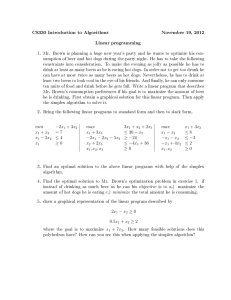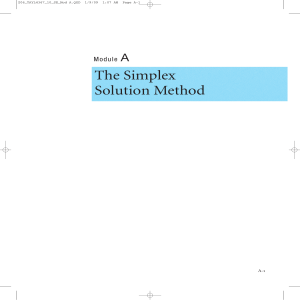15.081J/6.251J Introduction to Mathematical Programming Lecture 6: The Simplex Method II
advertisement
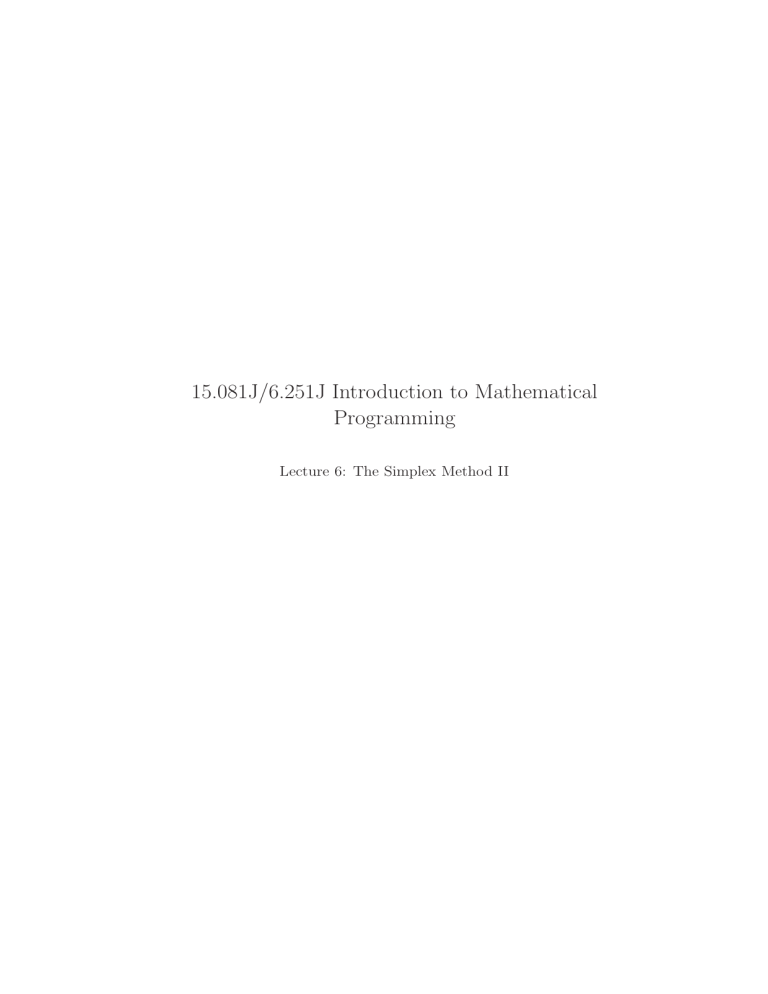
15.081J/6.251J Introduction to Mathematical
Programming
Lecture 6: The Simplex Method II
1
Outline
Slide 1
• Revised Simplex method
• The full tableau implementation
• Anticycling
2
Revised Simplex
Slide 2
Initial data: A, b, c
1. Start with basis B = [AB(1) , . . . , AB(m) ]
and B −1 .
2. Compute p′ = c′B B −1
cj = cj − p ′ A j
• If cj ≥ 0; x optimal; stop.
• Else select j : cj < 0.
Slide 3
3. Compute u = B
−1
Aj .
• If u ≤ 0 ⇒ cost unbounded; stop
• Else
4. θ∗ =
min
1≤i≤m,ui >0
xB(i)
uB(l)
=
ui
ul
5. Form a new basis B by replacing AB(l) with Aj .
6. yj = θ∗ , yB(i) = xB(i) − θ∗ ui
Slide 4
7. Form [B −1 |u]
8. Add to each one of its rows a multiple of the lth row in order to make the
last column equal to the unit vector el .
−1
The first m columns is B .
2.1
Example
Slide 5
min x1 + 5x2
s.t. x1 + x2 +
x1
x1 ,
−2x3
x3
x3
3x2 + x3
x2 ,
x3
1
≤4
≤2
≤3
≤6
≥0
Slide 6
B = {A1 , A3 , A6 , A7 },
BFS: x = (2, 0, 2, 0, 0, 1, 4)′
′
c = (0,
7, 0, 2, −3, 0,0)
1 1 0 0
0
1 0 0
1 0 0 0
1 −1 0 0
−1
B=
0 1 1 0 , B = −1
1 1 0
−1
1 0 1
0 1 0 1
(u1 , u3 , u6�, u7 )′ =�B −1 A5 = (1, −1, 1, 1)′
θ∗ = min 21 , 11 , 41 = 1, l = 6
l = 6 (A6 exits
the basis).
0
1 0 0
1
1 −1 0 0 −1
[B −1 |u] =
−1
1 1 0
1
−1
1 0 1
1
1 0 −1 0
0 0
−1
1 0
⇒B =
−1 1
1 0
0 0 −1 1
2.2
Practical issues
Slide 7
Slide 8
• Numerical Stability
B −1 needs to be computed from scratch once in a while, as errors accu­
mulate
• Sparsity
B −1 is represented in terms of sparse triangular matrices
3
Full tableau implementation
Slide 9
−c′B B −1 b
c′ − c′B B −1 A
B −1 b
B −1 A
or, in more detail,
−c′B xB
c1
xB(1)
..
.
|
B −1 A1
xB(m)
|
...
cn
|
...
B −1 An
|
2
3.1
Example
Slide 10
min −10x1 − 12x2 − 12x3
s.t.
x1 + 2x2 + 2x3 ≤ 20
2x1 + x2 + 2x3 ≤ 20
2x1 + 2x2 + x3 ≤ 20
x1 , x2 , x3 ≥ 0
min −10x1 − 12x2 − 12x3
s.t.
x1 + 2x2 + 2x3 + x4
= 20
2x1 + x2 + 2x3
+ x5
= 20
2x1 + 2x2 +
x3
+ x6 = 20
x1 , . . . , x6 ≥ 0
BFS: x = (0, 0, 0, 20, 20, 20)′
B=[A4 , A5 , A6 ]
Slide 11
x1
x2
x3
x4
x5
x6
0
−10
−12
−12
0
0
0
x4 =
20
1
2
2
1
0
0
x5 =
20
2*
1
2
0
1
0
x6 =
20
2
2
1
0
0
1
c′ = c′ − c′B B −1 A = c′ = (−10, −12, −12, 0, 0, 0)
Slide 12
x1
x2
x3
x4
x5
x6
100
0
−7
−2
0
5
0
x4 =
10
0
1.5
1*
1
−0.5
0
x1 =
10
1
0.5
1
0
0.5
0
x6 =
0
0
1
−1
0
−1
1
Slide 13
x1
x2
x3
x4
x5
x6
120
0
−4
0
2
4
0
x3 =
10
0
1.5
1
1
−0.5
0
x1 =
0
1
−1
0
−1
1
0
x6 =
10
0
2.5*
0
1
−1.5
1
Slide 14
3
x1
x2
x3
x4
x5
x6
136
0
0
0
3.6
1.6
1.6
x3 =
4
0
0
1
0.4
0.4
−0.6
x1 =
4
1
0
0
−0.6
0.4
0.4
x2 =
4
0
1
0
0.4
−0.6
0.4
Slide 15
x3
.
B = (0,0,10)
A = (0,0,0)
.
.
E = (4,4,4)
.
.
C = (0,10,0)
D = (10,0,0)
x2
x1
4
Comparison of implementations
Slide 16
5
5.1
Full tableau
Revised simplex
Memory
O(mn)
O(m2 )
Worst-case time
O(mn)
O(mn)
Best-case time
O(mn)
O(m2 )
Anticycling
Degeneracy in Practice
Slide 17
Does degeneracy really happen in practice?
n
�
xij = 1
j=1
n
�
xij = 1
i=1
xij ≥ 0
4
n! vertices:
For each vertex ∃ 2n−1 nn−2 different bases (n = 8) for each vertex ∃ 33, 554, 432
bases.
5.2
Perturbations
Slide 18
(P ) min c′ x
(Pǫ ) min
c′ x
s.t. Ax = b
s.t.
x≥0
5.2.1
Ax = b +
ǫ
ǫ2
..
.
ǫm
x ≥ 0.
Theorem
Slide 19
∃ ǫ1 > 0: for all 0 < ǫ < ǫ1
ǫ
Ax = b + ...
ǫm
x≥0
is non-degenerate.
5.2.2
Proof
Slide 20
Let B 1 , . . . , B r be all the bases.
r
ǫ
b1 + B r11 ǫ + · · · + B r1m ǫm
.
..
B −1
r b + .. =
.
r
ǫm
where:
B −1
r
•
r
bi
bm + B rm1 ǫ + · · · + B rmm ǫm
B r11
= ...
B rm1
B r1m
..
−1
, Br b =
.
· · · B rmm
···
r
b1
..
.
r
bm
+ B ri1 θ + · · · + B rim θm is a polynomial in θ
r
• Roots θi,r1 , θi,r2 , . . . , θi,m
r
r
• If ǫ �= θi,r1 , . . . , θi,m
⇒ bi + B ri1 ǫ + · · · + B rim ǫm �= 0.
• Let ǫ1 the smallest positive root ⇒ 0 < ǫ < ǫ1 all RHS are =
� 0 ⇒
non-degeneracy.
5
Slide 21
5.3
Lexicography
Slide 22
L
• u is lexicographically larger than v, u > v, if u =
� v and the first
nonzero component of u − v is positive.
• Example:
L
(0, 2, 3, 0) > (0, 2, 1, 4),
L
(0, 4, 5, 0) < (1, 2, 1, 2).
5.4
Lexicography-Pertubation
5.4.1
Theorem
Slide 23
Let B be a basis of Ax = b, x ≥ 0. Then B is feasible for Ax = b +
′
(ǫ, . . . , ǫm ) , x ≥ 0 for sufficiently small ǫ if and only if
L
ui = (bi , Bi1 , . . . , Bim ) > 0, ∀ i
B −1 = (Bij )
(B −1 b)i = (bi )
5.4.2
Proof
Slide 24
B is feasible for peturbed problem “⇔” B −1 (b + (ǫ, . . . , ǫm )′ ) ≥ 0 ⇔
bi + B i1 ǫ + · · · + B im ǫm ≥ 0 ∀ i
⇔ First non-zero component of ui = (bi , Bi1 , . . . , Bim ) is positive ∀ i.
5.5
Summary
Slide 25
1. We start with: (P ) : Ax = b, x ≥ 0
2. We introduce (Pǫ ): Ax = b + (ǫ, . . . , ǫm )′ , x ≥ 0
L
3. A basis is feasible + non-degenerate in (Pǫ ) ⇔ ui > 0 in (P ).
L
4. If we maintain ui > 0 in (P ) ⇒ (Pǫ ) is non-degenerate ⇒ Simplex is
finite in (Pǫ ) for sufficiently small ǫ.
5.6
Lexicographic pivoting rule
1. Choose an entering column Aj arbitrarily, as long as cj < 0; u = B −1 Aj .
2. For each i with ui > 0, divide the ith row of the tableau (including the
entry in the zeroth column) by ui and choose the lexicographically smallest
row. If row l is lexicographically smallest, then the lth basic variable xB(l)
exits the basis.
6
Slide 26
5.6.1
Example
Slide 27
• j=3
•
1
0
5
3
···
2
4
6
−1
···
3
0
7
9
···
• xB(1) /u1 = 1/3 and xB(3) /u3 = 3/9 = 1/3.
• We divide the first and third rows of the tableau by u1 = 3 and u3 = 9,
respectively, to obtain:
•
1/3
0
5/3
1
···
∗
∗
∗
∗
···
1/3
0
7/9
1
···
• Since 7/9 < 5/3, the third row is chosen to be the pivot row, and the
variable xB(3) exits the basis.
5.6.2
Uniqueness
Slide 28
• Why lexicographic pivoting rule always leads to a unique choice for the
exiting variable?
• Otherwise, two rows in tableau proportional ⇒ rank(B −1 A) < m ⇒
rank(A) < m
5.7
Theorem
Slide 29
If simplex starts with all the rows in the simplex tableau, other than the zeroth
row, lexicographically positive and the lexicographic pivoting rule is followed,
then
(a) Every row of the simplex tableau, other than the zeroth row, remains
lexicographically positive throughout the algorithm.
(b) The zeroth row strictly increases lexicographically at each iteration.
(c) The simplex method terminates after a finite number of iterations.
5.8
Smallest subscript
pivoting rule
Slide 30
1. Find the smallest j for which the reduced cost cj is negative and have the
column Aj enter the basis.
2. Out of all variables xi that are tied in the test for choosing an exiting
variable, select the one with the smallest value of i.
7
MIT OpenCourseWare
http://ocw.mit.edu
6.251J / 15.081J Introduction to Mathematical Programming
Fall 2009
For information about citing these materials or our Terms of Use, visit: http://ocw.mit.edu/terms.

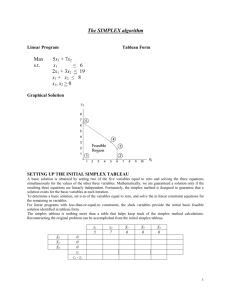
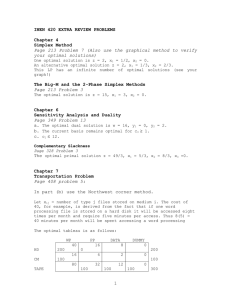
![INSERT routine a ]. );](http://s2.studylib.net/store/data/013191697_1-80c58dc9f9c6a59985f5c9d069d1df5d-300x300.png)
